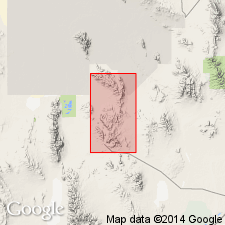
- Usage in publication:
-
- Shadscale formation*
- Modifications:
-
- Named
- Dominant lithology:
-
- Dolomite
- Limestone
- Siltstone
- Shale
- AAPG geologic province:
-
- Great Basin province
Summary:
Named for exposures near Shadscale Canyon, southern end Dugway Range, Juab Co, UT in the Great Basin province. Type section measured on east side of range along low ridge 0.6 mi north of Trailer Wash, T11S, R11W. Crops out in small patches east of Dugway Pass, along west side south end of Fandangle Canyon, along ridge south-southeast of Four Metals Mine, and on west side Dugway Range. Extends north into Tooele Co. Is 518 ft thick at type where it overlies Busby quartzite and underlies Trailer limestone (new). Thickens southward. Lower fourth is cream dolomite which weathers deep orange brown, medium-grained gray limestone, and green-gray dolomitic to calcitic slabby, micaceous siltstone. Upper three-fourths is fine-grained, blue-gray limestone and green-gray chloritic shale. Fossils not abundant and poorly preserved, include trilobites and alga GIRVANELLA. Is equivalent to all or part of Lyndon limestone, Chisholm shale, Eldorado dolomite. Of Middle Cambrian age. Lower part may be late Early Cambrian. Geologic map. Stratigraphic section.
Source: GNU records (USGS DDS-6; Denver GNULEX).
For more information, please contact Nancy Stamm, Geologic Names Committee Secretary.
Asterisk (*) indicates published by U.S. Geological Survey authors.
"No current usage" (†) implies that a name has been abandoned or has fallen into disuse. Former usage and, if known, replacement name given in parentheses ( ).
Slash (/) indicates name conflicts with nomenclatural guidelines (CSN, 1933; ACSN, 1961, 1970; NACSN, 1983, 2005, 2021). May be explained within brackets ([ ]).

